SEO Copywriting Guide: Write Content That Rank and Convert
Are you an online business owner looking to expand your digital footprint? Or a budding entrepreneur about to launch your E-enterprise?
SEO copywriting is one skill you mustn’t overlook. Here’s why.
The number of online consumers has been on an upward trajectory ever since COVID-19 hit. In 2022, there were 2.48 billion online buyers.
Fast forward to 2023, that number has risen to 2.64 billion, indicating an increase of over 80 million within 12 months.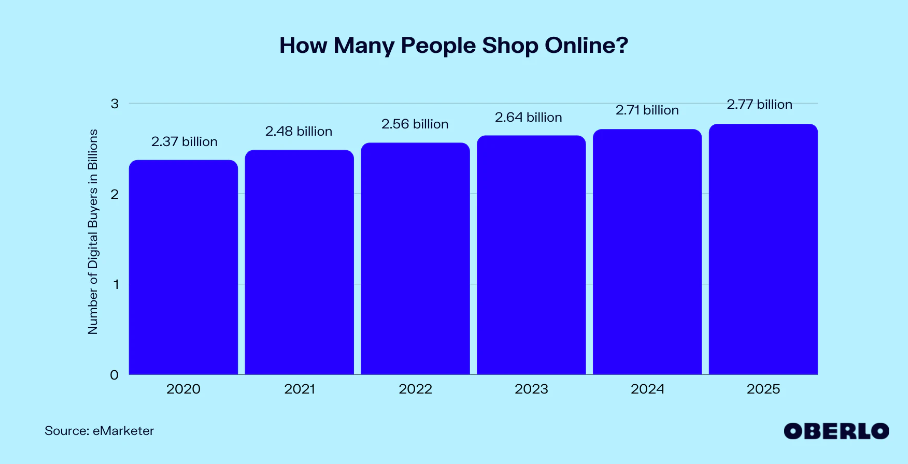
(Source, Oberlo).
With the current world population at over 8 billion, it means 33.3% of the world population are online consumers.
In other words, one in every three people alive buys something online. And guess where they go to start their purchase journey?
You are right, Google.

To get in front of these potential buyers, your business must appear on Google search results pages. But not only that.
Your content must be compelling enough to make them buy from you.
But how do you climb the ranks on search engine result pages and still capture the hearts of your audience?
That’s what SEO copywriting is all about- creating content that strikes a chord with your target audience and, at the same time, appeals to search engines.
Table of Contents
- The Fundamentals of SEO Copywriting
- What Is SEO Copywriting?
- Stages of SEO Copywriting
- Type of Research for SEO Copywriting
- Keyword Research for SEO Copywriting
- Understanding Search Terms and Search Intents
- Search Intent for SEO and Copywriting
- Tools to Find Keywords for SEO Copywriting
- Long-Tail Keywords and Latent Semantic Indexing Keywords
- How to perform customer and product research for copywriting
- Copywriting strategies to cut out the guesswork when writing your copy
- Advanced persuasive copywriting techniques to skyrocket conversion
- How to edit and proofread your copy for conversion (Coming soon)
- Mistakes to avoid when writing a copy (Coming soon)
The Fundamentals of SEO Copywriting
What Is SEO?
SEO stands for Search Engine Optimization.
It’s the process of improving your web page’s visibility for relevant search queries.
Like you, here’s how every online consumer starts their purchase journey:
- Head over to Google,
- Type keywords into the search box and hit enter.
- Glance through the results to select whatever looks best.
Those pages you see on the result page aren’t by accident. It’s SEO in action.
Doing SEO right helps rank your website or a piece of content for specific search terms (keywords) on Search Engine Results Pages (SERPs).

However, you should know that Google and other search engine algorithms are ever-evolving.
Gone are those days of slapping keywords onto content for SEO gains. Keyword-stuffing before? It’s a punishable offense under the search engine code of conduct.
Today, quality is king. Google now evaluates content using the E-E-A-T metrics.
Likewise, the shares and links a content receives are signals of authority instrumental to ranking.
That said, the baseline remains keyword research. That’s where any SEO writing project starts.
No matter how stellar your writing is, search crawlers don’t care if you can’t say to them:
“Hey, I’m on the web, and here’s what I stand for.”
What Is Copywriting?
Copywriting is the art and science of delivering words that persuade people to take a specific action.
The goal of a copy is to make your audience exchange their hard-earned money for what you sell. In other words, copywriting is writing to sell.
There are several definitions of copywriting. If you study them enough, you can summarize all as – writing to prompt actions from a target audience.
The text you write for landing pages, website pages, PPC ads, sales emails, and product pages are all examples of copywriting.
What Is SEO Copywriting?
SEO copywriting merges copywriting techniques with SEO practices.
It’s about creating high-quality content that appeals to users and search engines.
Besides writing chiefly for conversion, It involves finding out how your target audience searches for your products/services, what words they use, and optimizing your web page for those keywords.
Hence, the goal of SEO copywriting is to;
- Generate leads via organic traffic and
- Convert the leads
Why Is SEO Copywriting Important?
Your business benefits in many ways when you get SEO copywriting right:
- Your content sounds more natural and resonates with your audience better because it uses their words
- You generate qualified leads from the traffic on your website because your content is created for a defined audience.
- Unlike paid traffic which ends when you stop spending, it’s more cost-effective (than any other form of marketing).
- The result is long-lasting. One successful SEO copywriting project guarantees continuous ROI for years to come.
- No matter how persuasive a copy is, it’s dead and buried without traffic.
- Likewise, traffic is of no use when a copy is lifeless. To rub salt into the wound is to purchase traffic for such copy.
What Does an SEO Copywriter Do?
An SEO copywriter pairs copywriting techniques with SEO know-how to deliver content that ranks and sells.
Writing an SEO copy for your business means you must –
- Know how to perform audience and product research,
- Get acquainted with psychological triggers, and
- Understand the art of persuasion.
For SEO, you have to –
- Write with the search algorithm in mind,
- Understand keywords and the search intent behind them, and
- Structure your content in a search-friendly format
Stages of SEO Copywriting
Copywriting is communication first, then selling.
Simple, clear, and easy is the experience every online user wants. Give it to them, and you’ll be on your way to having their wallet.
But that’s only possible if you know where and how to start. SEO copywriting isn’t a haphazard process. It involves 3 unskippable stages.
I call it the lifecycle of an SEO copywriting project:
- The prewriting stage -The research phase
- The writing stage – Wording it right
- The Post-Writing Stage -The editing phase
The Prewriting Stage: Research for SEO Copywriting
This is the most important phase in your copy lifecycle. The efficacy of your copy hinges upon the depth of your research.
There’s no eureka moment to nail it. And no inspiration or guesswork can get you close.
Research and only real research works here. Let me restate that with a legendary emphasis;
Advertising people who ignore research are as dangerous as generals who ignore decodes of enemy signals.
David Ogilvy.
Before you can come up with anything close to a decent copy, you need first-hand knowledge about-
- Your Audience
- Your products
- Your Competitors
You are only ready to write when you have more than surface-level facts about them.
That’s not to say copywriters are experts in all fields. The point is-
A copywriter must know enough to sell the clients’ products, not much to impress the readers.
Plus, you aren’t one. You are just a business owner with several other commitments.
Next, let’s see how to gather knowledge to power your writing.
Type of Research for SEO Copywriting
- Customer/Audience Research
- Product Research
- Competitor Research
Your audience first…
To understand your audience, you need to conduct two types of research;
- The first is Keyword Research – To uncover what words your audience uses to search for your product/service online.
- Secondly, Customer Research – To know consumers’ pain and the type of solution they seek.
By walking this path, you’ll see where search terms and users’ words overlap.
Let’s start…
Keyword Research for SEO Copywriting
The immediate benefit of keyword research comes in two folds:
- First, you will find words people use to search for your business online, and you can use those words in your copy.
- As a result, those keywords, now in your content, inform search engines to show your website for relevant search queries.
Understanding Search Terms and Search Intents
Search terms are words that users type into Google when searching. They are also called keywords or key phrases.
Search intent is the “why” behind the keywords. By implication, the more relevant your content is to search intent, the more likely it will rank for that specific keyword.
Understanding search intent lets you focus your copy on an ultra-specific audience and write content to meet their expectations.
What Are the Best Keywords for SEO Copywriting?
No brainer. The best keywords for copywriting are those with high commercial intent.
Keywords with signals of transactional readiness are more likely to result in sales.
The search intent topic is a deep one. I’ll only do a surface scratch here to get us going.
Types of Search Intent
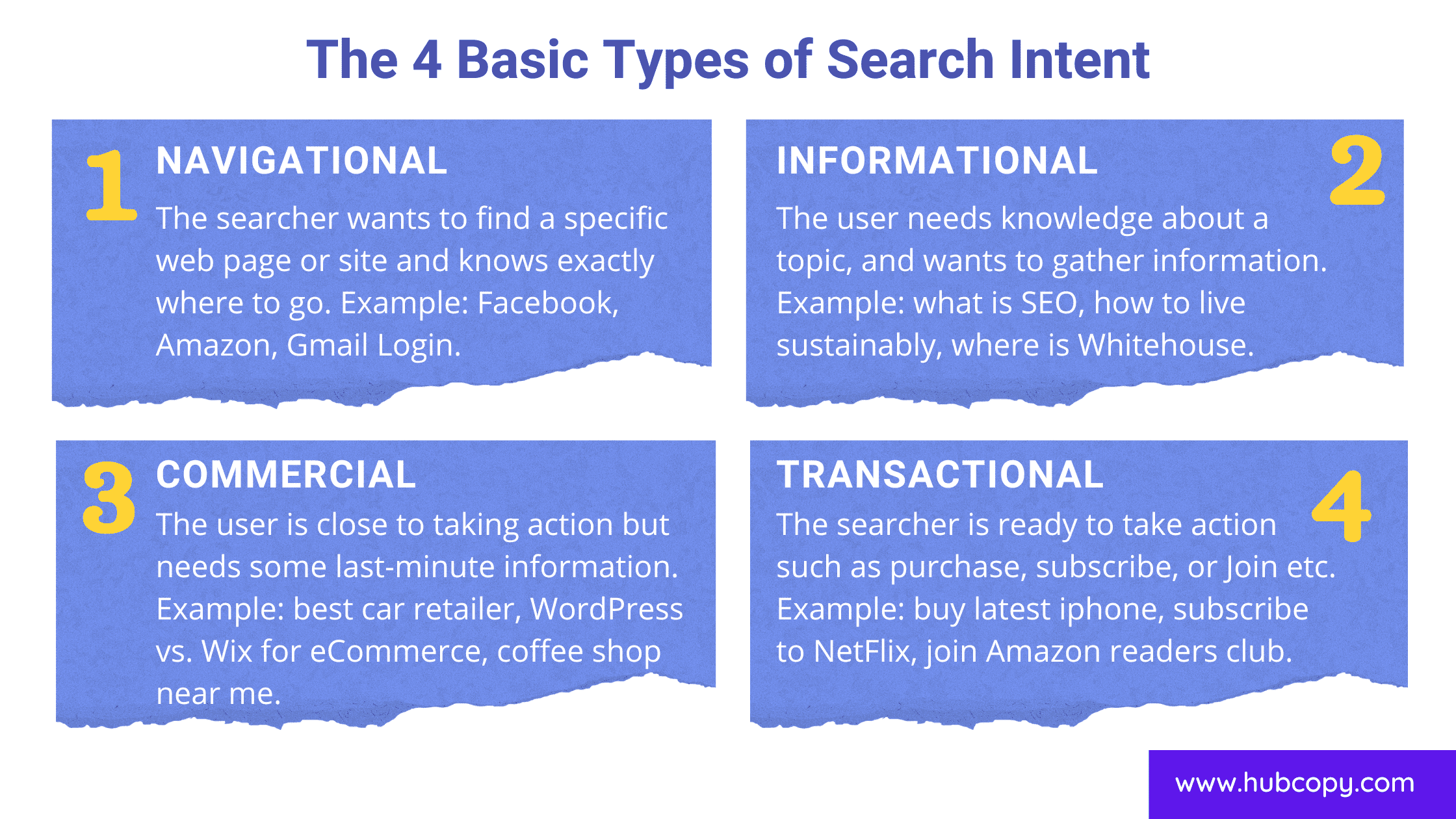
- Navigational: The searcher wants to find a specific web page or site and knows exactly where to go. Example: Facebook, Amazon, Gmail Login.
- Informational: The user needs knowledge about a topic and wants to gather information. E.g., what is SEO, how to live sustainably, where is Whitehouse.
- Commercial: The user is close to taking action but needs some last-minute information. Search like best car retailer, WordPress vs. Wix for eCommerce, coffee shop near me.
- Transactional: The searcher is ready to take action such as purchase, subscribe, Join etc. Example: buy latest iPhone, subscribe to NetFlix.
Search Intent for SEO and Copywriting
When you understand search intent, you can separate keywords based on what they are most likely to rank for.
For example, a search term like “features of running shoes” is informational and ideal for a blog article.
On the other hand, “Affordable running shoes” has a transactional intent. This means people searching with it are close to conversion.
High commercial intent keywords or transactional keywords are what you should target in copywriting.
Keywords like “best deals on iPhones,” “buy running shoes online,” “get discount on car purchase,” “affordable copywriting service,” cheapest ATV tours,” etc., attract more qualified leads.
Also, Google takes product and service queries as searches with commercial intents.
Examples are “running shoes,” “copywriting service,” and “ATV tours.”
Now you’ve learned search intent in theory. Wouldn’t it be nice to see it in practice?
How Google Uses Search Intent for Search Results
To show that Google uses search intent to determine what appears on the result page, we’ll google the 3 keywords below and see what the result page looks like for each.
- Features of running shoes
- Buy running shoes
- Running shoes
1. Search result page for “Features of running shoes”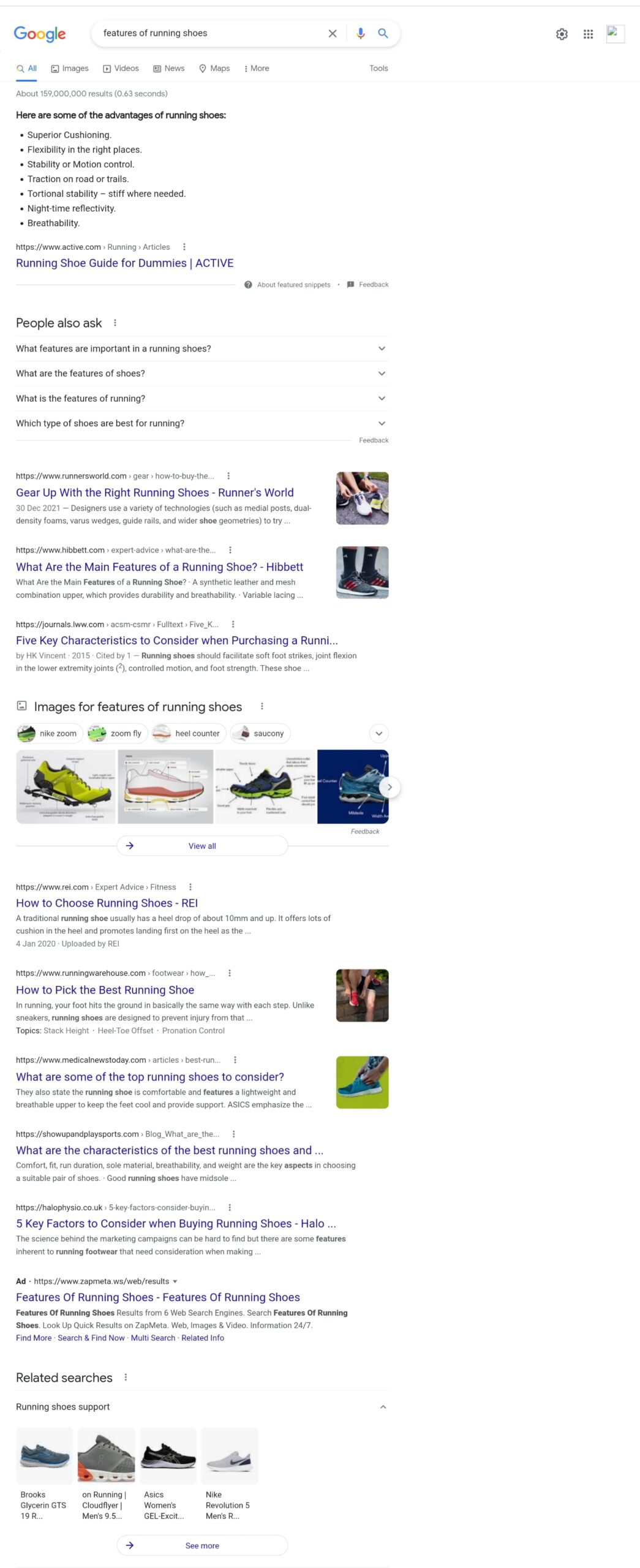
2. Search result page for “Buy running shoes”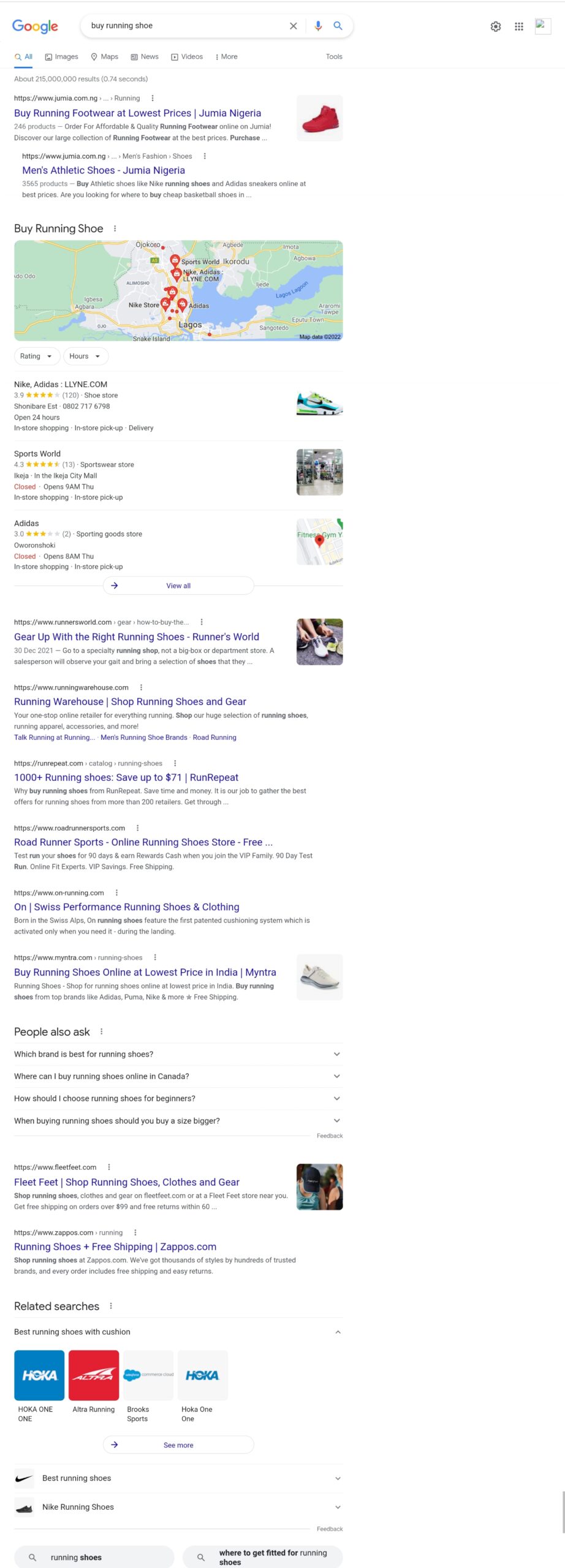
3. Search result for “Running shoes”
We can deduce the following points from the above Search Engine Result Pages (SERPs)
1. Google treats “features of running shoes” as a query with informational intent. The result page is dominated by web pages that are so relevant – You can see the results are blog articles, mostly from affiliate sites.
2. “Buy running shoes” has a transactional intent, which is why Google populated the result page with e-commerce stores.
3. Product or service queries like “Running shoes” are commercial in intent. The result page is a reflection of that.
The key takeaways here are:
- Search intent is the reason why Google ranks web pages.
- Keywords that are irrelevant to intent de-rank your content.
- When you put “type and features” as target keywords in a copy, Google will likely treat such content as a blog and rank it as informational.
Tools to Find Keywords for SEO Copywriting
NOTE: The keyword research discussed below can be used for all content types.
There are as many ways as there are tools to dig up keywords. To make sure you are able to follow this guide, we’ll stick to those with zero-barrier entry.
- Google Auto-suggest
- Google Related Searches
- Google Keyword planner
- LSI Graph
- SEMrush Keyword Tool
- SEMrush SEO Content Template
1. Google Auto-suggest
Head over to Google. Type your product type or services into the search field. As you type in your query, Google automatically suggests keywords related to your search term.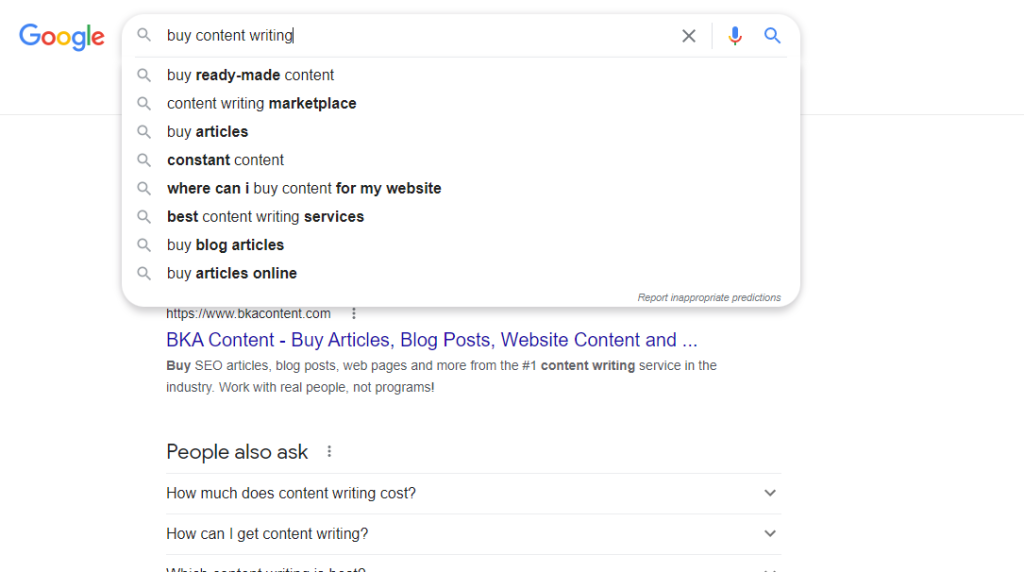
Those are relevant and important keyword variants. Try to keep them somewhere for when you are ready to write.
2. Google Related Searches
You can also find search terms relevant to your queries at the bottom of the result page. Google displays them as related searches because people who search with the keywords you input also use them.
3. Google Keyword Planner For Keyword Research
Keyword Planner is a free tool from Google that you can play around with. The keywords you discover here are backed with Google’s historical data and have high-ranking potential.
4. LSI graph
LSI graph is another plug-and-play tool you can use to generate relevant keywords. You can generate up to 50 Latent Semantic Indexing keywords from a single search.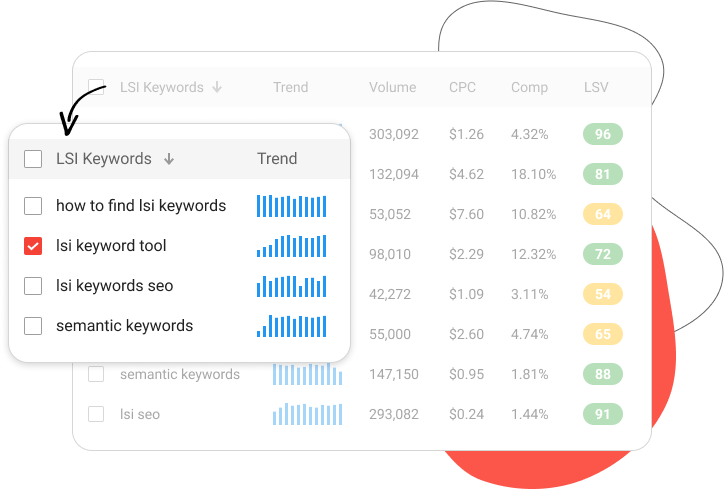
5. SEMrush For Keyword Research
SEMrush is the go-to platform for SEO-intrigued copywriters. SEMrush SEO tools offer a wide range of features to help you optimize your content and your entire website.
You can use the Keyword Overview feature to find insight on how to rank for a specific keyword.
Simply log in to your account or create a new one. You can start with SEMrush’s free trial and upgrade to a paid plan later.
Once you log in, click the Keyword Overview tab, and type your keyword into the available field. The result looks like this;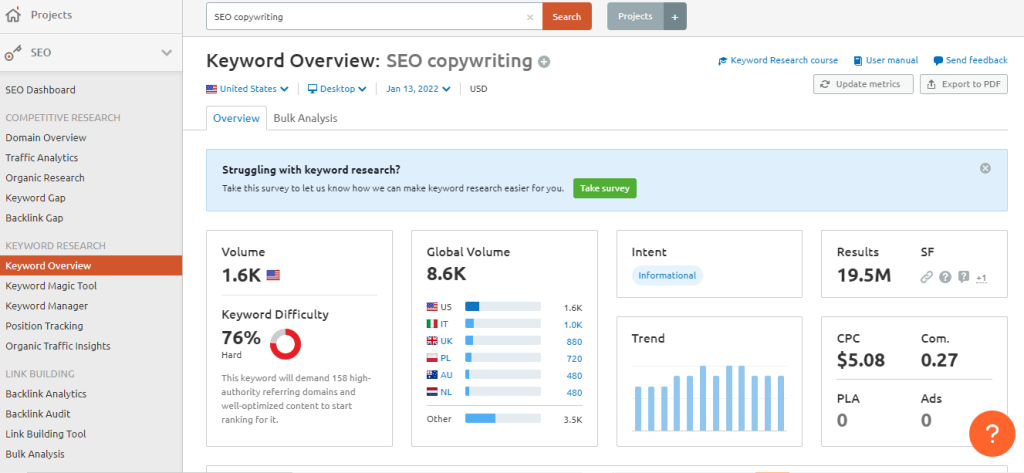
On this screen, you can see –
- The search volume: This data tells how many people search for this keyword.
- You can filter search volume based on location (crucial for targeted and local SEO).
- You can also see how competitive it is to rank for your target keyword. Plus, there are variations of these keywords with tons of insights.
You can dig deeper by using the Keyword Magic Tool and a host of other great features.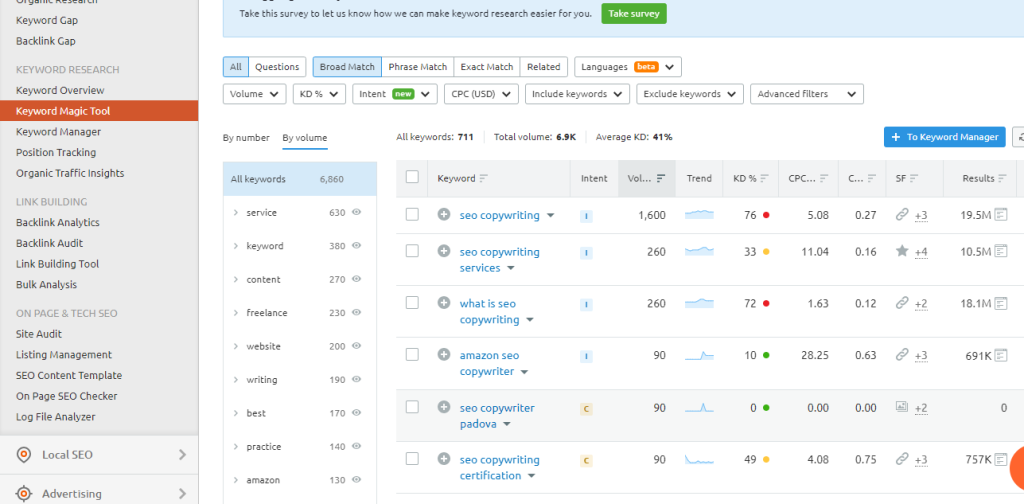
SEMrush is a powerful tool to broaden your keyword research scope.
6. SEMrush SEO Content Template
The SEO Content Template is one of the most useful features you will ever come across in an SEO tool.
While it’s not typically for keyword discovery, it shows you what your competitors are doing right and tips on how to outrank them.
After inputting your target keyword, click the SEO Content Template tab on the left panel and hit Enter.
You’ll get the data behind the top ten results on SERPs. You also get key writing recommendations such as text length and readability to outrank these sites.
On top of that, you have a long list of semantically related keywords to boost contextual authority.
Long-Tail Keywords and Latent Semantic Indexing Keywords
So far, each of the keyword variations you uncovered can be grouped either as LSI or Long-Tail.
A Long-Tail keyword is an extension of the primary keywords (4 or more words including the primary keyword)
Latent Semantic Indexing Keywords represent niche-related or topic-related words. They are words that are often seen together on the web.
Importance of Latent Semantic Indexing Keywords And Long-Tail Keywords for SEO and Copywriting
Even though some people use both terms interchangeably, they are 2 different terms that serve different purposes.
Long Tail keywords are longer versions of the primary keywords used to satisfy search intents, while LSI keywords are contextually related terms search engines use to determine topical relevance in searches.
But why do they matter?
Importance of Latent Semantic Indexing Keywords
Imagine using a single keyword up to 30 times in a web copy.
What happens if you are the reader? Boring, right? Off course. Super boring.
It irritates search engines as much as users. That’s where LSI keywords come into play.
- LSI keywords are semantically related words or phrases that give search engines a contextual understanding of your content.
- LSI saves your content from keyword repetition that might lead to keyword stuffing.
- Using LSI keywords makes your writing natural.
For instance, the term “Python” can mean several things to search engines. But words like software development, programming language, coding, computer, and programmers used together help Google understand what “Python” in your content means.
Importance of Long-Tail Keywords
Unlike LSI, long-tail keywords contain the head terms and extra words that searchers use to narrow search results.
- The number one benefit of long-tail keywords is their relatively low search volume and competition. Thus, they are easier to rank for.
Look at this;
The keyword “running shoes” has over 2 billion pages ranking for it on Google.
A longer “Affordable running shoes” beats the competition down to over 25 million- a whopping 98.75% reduction in competition.
The long-tail “Best affordable running shoes for men” search lessens the competition even more to 14 million.
Add location, and you get even less competition. Go for “best affordable running shoes for men in Auckland,” and you have only 6 million pages to outrank.
From 2 billion to 6 million, you have just given your website a 99% chance at ranking. That’s long-tail keywords for you. The longer the query, the lesser the competition.
- The number 2 benefit of Long-tail keywords is that their users are closer to conversion.
A searcher who uses long-tail queries usually looks for something specific and is closer to making a purchase.
Like above- The longer the query, the more specific the search becomes.
HINT: If you are giving PPC a shot, targetting short-tail words can quickly finish your advertising budget without yielding significant returns. Bidding on long-tail keywords is more affordable due to the low competition and they have better conversion rates.
SEO Copywriting Continues…
While this basic understanding of SEO, keywords, and search intents might not put you instantly on page one of Google, you will be far ahead of millions of other websites that do nothing in this respect.
It doesn’t end here. The next part of this guide is where you’ll learn how to conduct customer and product research. See ya!
Go to Next: How to Perform Customer and Product Research for Copywriting.


